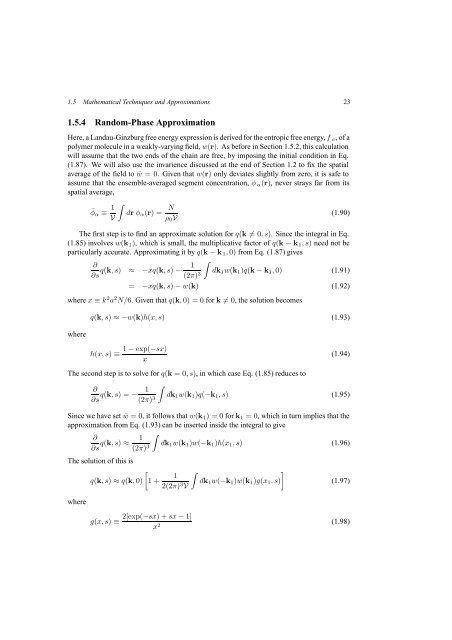Self-Consistent Field Theory and Its Applications by M. W. Matsen
Self-Consistent Field Theory and Its Applications by M. W. Matsen
Self-Consistent Field Theory and Its Applications by M. W. Matsen
Create successful ePaper yourself
Turn your PDF publications into a flip-book with our unique Google optimized e-Paper software.
1.5 Mathematical Techniques <strong>and</strong> Approximations 23<br />
1.5.4 R<strong>and</strong>om-Phase Approximation<br />
Here, a L<strong>and</strong>au-Ginzburg free energy expression is derived for the entropic free energy, f e ,ofa<br />
polymer molecule in a weakly-varying field, w(r). As before in Section 1.5.2, this calculation<br />
will assume that the two ends of the chain are free, <strong>by</strong> imposing the initial condition in Eq.<br />
(1.87). We will also use the invarience discussed at the end of Section 1.2 to fix the spatial<br />
average of the field to ¯w =0. Given that w(r) only deviates slightly from zero, it is safe to<br />
assume that the ensemble-averaged segment concentration, φ α (r), never strays far from its<br />
spatial average,<br />
¯φ α ≡ 1 V<br />
∫<br />
dr φ α (r) =<br />
N<br />
ρ 0 V<br />
(1.90)<br />
The first step is to find an approximate solution for q(k ≠0,s). Since the integral in Eq.<br />
(1.85) involves w(k 1 ), which is small, the multiplicative factor of q(k − k 1 ,s) need not be<br />
particularly accurate. Approximating it <strong>by</strong> q(k − k 1 , 0) from Eq. (1.87) gives<br />
∂<br />
q(k,s)<br />
∂s<br />
≈<br />
∫<br />
1<br />
−xq(k,s) −<br />
(2π) 3 dk 1 w(k 1 )q(k − k 1 , 0) (1.91)<br />
= −xq(k,s) − w(k) (1.92)<br />
where x ≡ k 2 a 2 N/6. Given that q(k, 0) = 0 for k ≠0, the solution becomes<br />
where<br />
q(k,s) ≈−w(k)h(x, s) (1.93)<br />
h(x, s) ≡ 1 − exp(−sx)<br />
x<br />
(1.94)<br />
The second step is to solve for q(k =0,s), in which case Eq. (1.85) reduces to<br />
∂<br />
∂s q(k,s)=− 1 ∫<br />
(2π) 3 dk 1 w(k 1 )q(−k 1 ,s) (1.95)<br />
Since we have set ¯w =0, it follows that w(k 1 )=0for k 1 =0, which in turn implies that the<br />
approximation from Eq. (1.93) can be inserted inside the integral to give<br />
∂<br />
∂s q(k,s) ≈ 1 ∫<br />
(2π) 3 dk 1 w(k 1 )w(−k 1 )h(x 1 ,s) (1.96)<br />
The solution of this is<br />
where<br />
q(k,s) ≈ q(k, 0)<br />
g(x, s) ≡<br />
[<br />
∫<br />
1<br />
1+<br />
2(2π) 3 V<br />
]<br />
dk 1 w(−k 1 )w(k 1 )g(x 1 ,s)<br />
(1.97)<br />
2[exp(−sx)+sx − 1]<br />
x 2 (1.98)
















